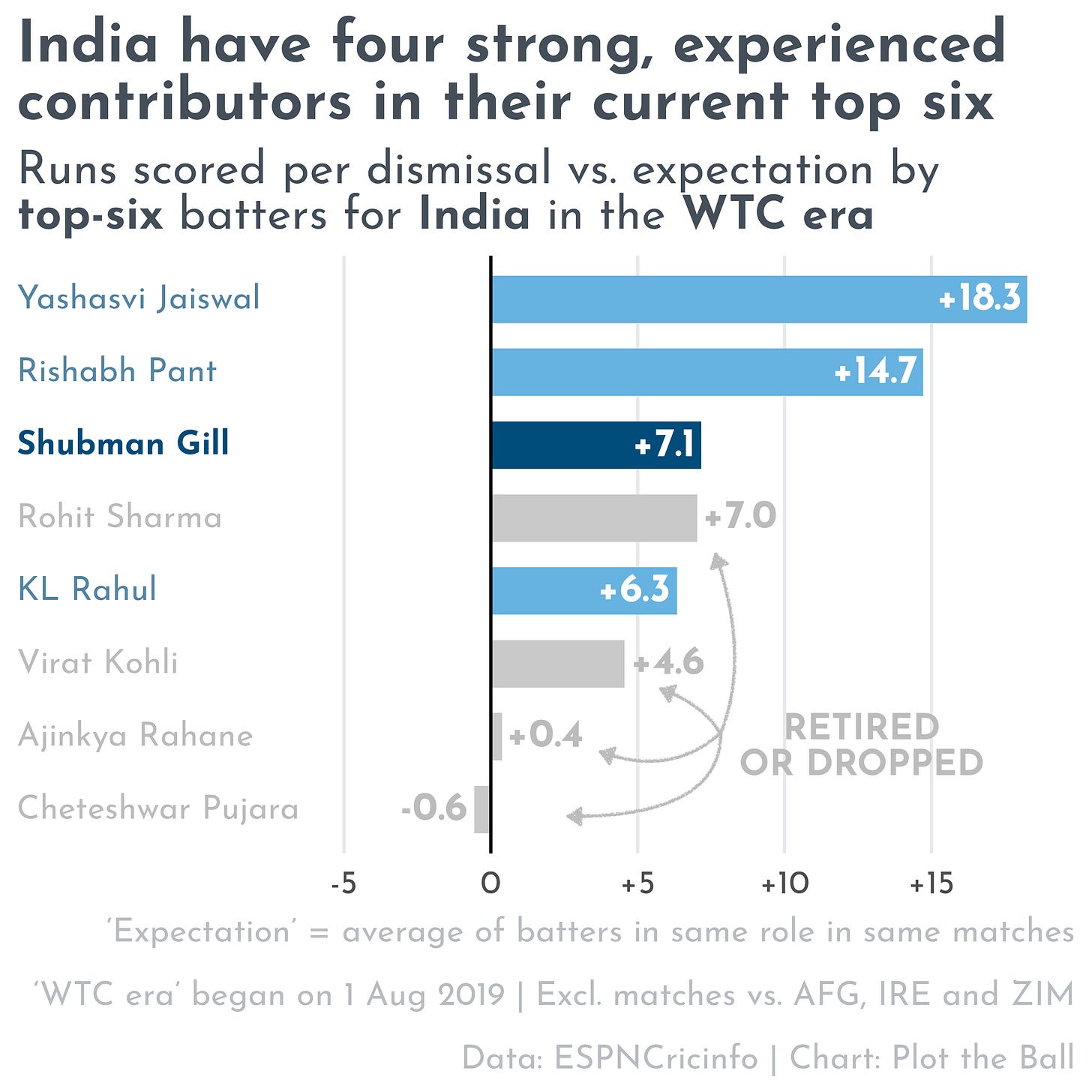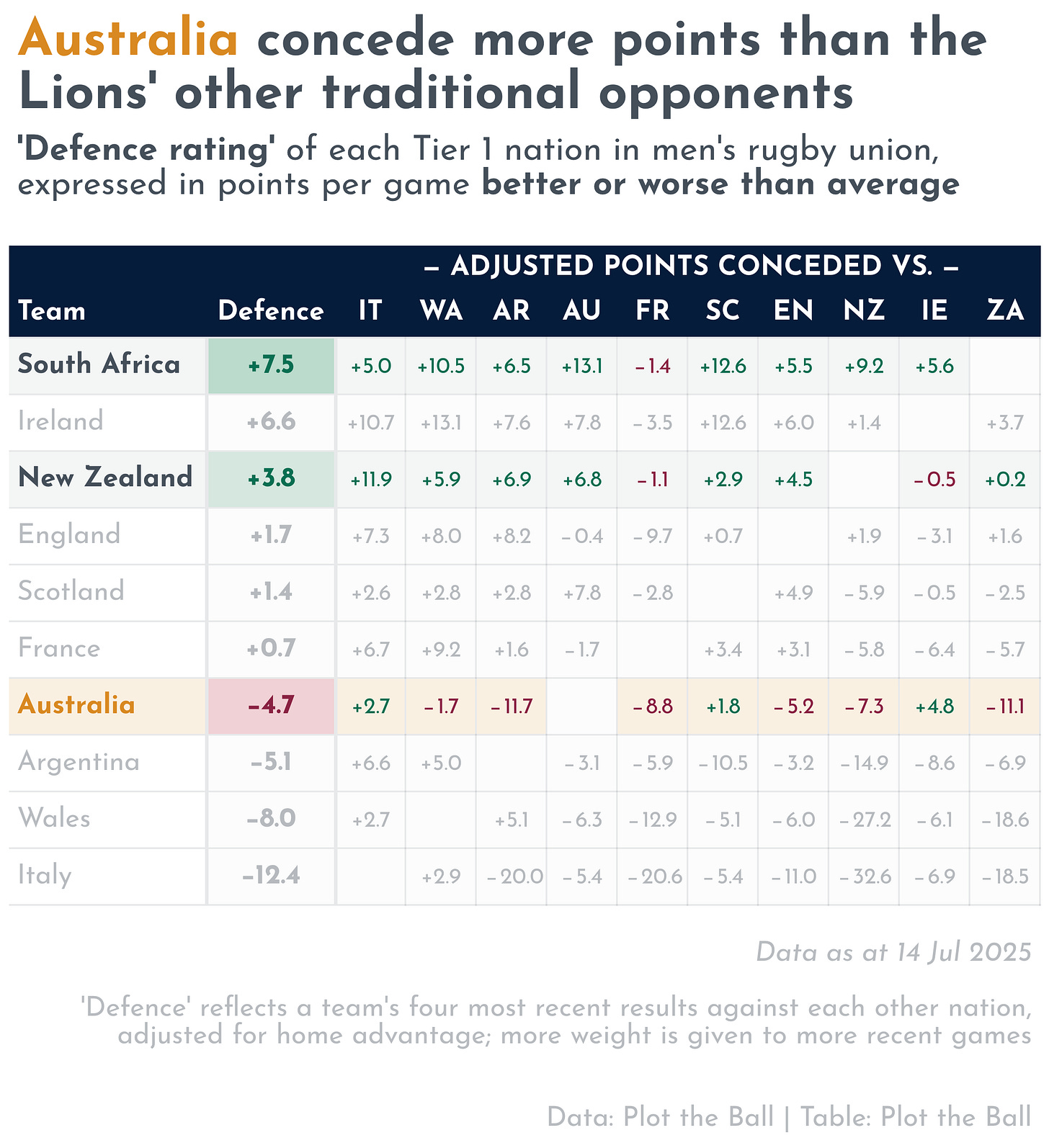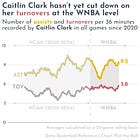🏏 Shubman Gill’s leap gives India a strong batting core — but their selection remains conservative
My Week in Sport(s) 🏏 🏉 🎾 ⚽️ ⚾️
Welcome to My Week in Sport(s) — a regular newsletter from Plot the Ball.
Covered in this edition: 🏏 Shubman Gill, 🏉 the Wallabies, 🎾 Iga Świątek, ⚽️ Ann-Katrin Berger and ⚾️ Shohei Ohtani.
🏏 Shubman Gill’s leap gives India a strong batting core — but their selection remains conservative
This newsletter often causes me to occupy a funny mental space. I want to write about the athletes I like watching the most — but have to remind myself not to get carried away in my assessment of their quality, just because they bring me a lot of joy.
No one forces me into that space as often as Shubman Gill. I’d choose to watch him bat over any other cricketer — but, before his first series as India’s red-ball captain, I described his career in the format as ‘solid but unspectacular’. After three tests against England — and three centuries — I think it’s fair to upgrade that judgement. With Gill’s step up, India now have a strong core to their test batting order: he joins Yashasvi Jaiswal, KL Rahul and Rishabh Pant as clearly above-average contributors.
In fact, they’ve been considerably better than the batters who passed them the torch. Judged by the runs they’ve scored per dismissal relative to other specialist batters in the same test matches, it’s clear that they are performing better than the team’s previous spine of Rohit Sharma, Virat Kohli, Ajinkya Rahane and Cheteshwar Pujara did — at least in the latter stages of their careers. In the World Test Championship era, Rahane and Pujara scored at about the match-average rate for batters in their roles.
Kohli — at 4.6 runs per dismissal above expectation — and Rohit (+7.0) were better than that, but their successors have been even stronger. Jaiswal and Pant are the two who stand out by this metric: Jaiswal is +18.3 compared to other top-order batters in his tests, while Pant has outperformed his middle-order peers by almost 15 runs. That India have been able to execute this batting transition without missing a beat is remarkable — but it’s disappointing they haven’t leveraged this strength in other ways.
With their core of plus batters, they could be aggressive in selecting the rest of their line-up — favouring players with wicket-taking ability over less threatening bowlers who might shore up their batting further. So far this series — as in Australia — they’ve chosen the latter. Maybe I’m just disappointed I haven’t yet seen the joyous Kuldeep Yadav in action — but the left-armer has taken wickets much more cheaply than other spinners in the tests he’s played, too. Sometimes, the head and heart really do align.
🏉 The weak defence of the Wallabies presents the British & Irish Lions with a golden opportunity
As we covered recently, Henry Pollock has many of the hallmarks of a talented young athlete. I missed an important one, though: his confidence. He won’t play in the first of the Lions’ three tests against Australia — but his name has still been in the headlines.
“We want to come here and be the best Lions team ever," Pollock said. "We have been talking about that loads and 3-0 is definitely on the table, hopefully.” The nature of a Lions tour means it’s much easier to assess the hosts in advance of the test series than the tourists, so let’s focus on the Wallabies for now. Is a whitewash really on the cards? Let’s look at one side of the ball — their defence — through the lens of the simple model of test-match rugby performance I introduced earlier in the year.
The ‘defence rating’ for each nation in the table above is based on the points they’ve conceded in their last four games against other top teams, adjusted for recency and home advantage. For Australia fans, it makes ugly reading: in their most recent set of fixtures, they have conceded around five more points per game than a typical ‘Tier 1’ team. With a below-average attack, too, Wales and Italy are currently the only weaker teams overall. It could be a torrid last few weeks on tour for Pollock and the Lions.
What else I learned last week
🎾 Iga Świątek’s surprising Wimbledon title was powered by her serve
After a disappointing 2025 season on the clay court, Iga Świątek quickly turned things around on grass. She made her first ever final on the surface in June, and followed that up a couple of weeks later by winning the Wimbledon singles title.
What changed on grass this year? No one at Wimbledon did better than Świątek on her own serve, as she won 69% of the points — and 91% of the games — that she initiated at the tournament. Her ace rate of 6.2% was the highest of any woman who reached the quarter-final stage, too. In fact, six of the 10 best serving performances by ace rate of her career have come this calendar year — including her dominant victory in last Saturday’s final over 23-year-old American Amanda Anisimova.
⚽️ Germany’s Ann-Katrin Berger is the most active goalie at Euro 2025
Two Euro 2025 quarter-finals have now been played, and two more remain. Today’s game between Spain and hosts Switzerland will be the biggest mismatch of the knockout stages; tomorrow, though, France against Germany could be a classic.
Before Euro 2025 began, we looked at the goalies who might stand out this summer. One of the top-rated shot-stoppers — at least based on publicly available data — was Germany’s Ann-Katrin Berger. She has had a very active role for her nation in open play, too: while Berger attempted 56 passes per 90 minutes in the group stage, other keepers averaged just 33. She has also made by far the most defensive interventions outside her own box: 5.7 per 90 minutes, while other goalies have averaged just 1.2.
⚾️ Shohei Ohtani has continued to shelve his splitter in his pitching return
Shohei Ohtani’s stuff has looked great in his graduated return to pitching after a long-term elbow injury. In five short outings so far, the average velocity of his fastball is actually up 1.4 mph from 2023 — the last time he was a full-time two-way player.
One trend in Ohtani’s usage of his different pitches has also continued. As we saw last week, the splitter is used much more frequently by Japanese pitchers in the major leagues than it is by all other players. And Ohtani deployed his heavily when he first arrived in North America: between 2018 and 2022, 16% of the pitches he threw at MLB level were splitters. In 2023, however, he turned to the pitch only 6% of the time — and it’s accounted for only five of the 140 pitches he’s thrown so far in 2025.
My Week in Sport(s) will be on an extended break for the next four weeks, and will return on Friday August 22nd.





